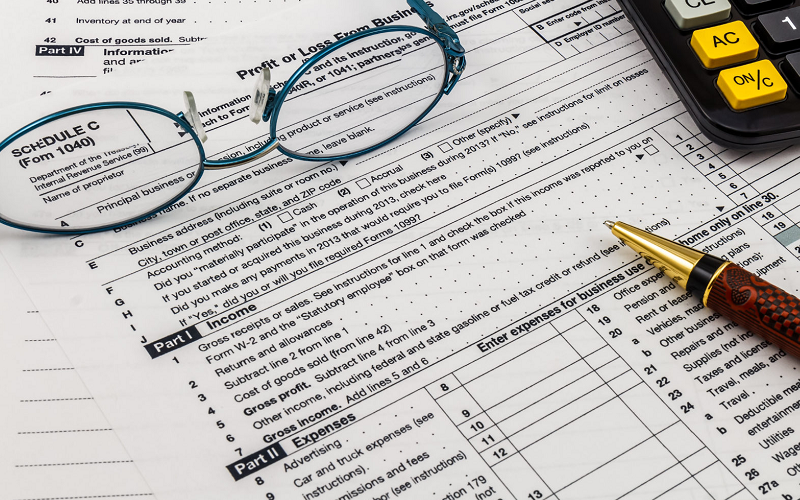
Welcome to the world of entrepreneurship, where the thrill of forging your own path comes with its own set of challenges — one of which is understanding the complex terrain of taxation. If you’re an LLC owner, one of the key tax-related topics you should be familiar with is estimated taxes. Here we demystify the concept of estimated taxes, particularly as they apply to owners of Limited Liability Companies (LLCs). Navigating through tax rules can be daunting, especially when the implications of not paying accurate estimated taxes can range from fines to potential legal trouble.
Contents
Understanding the Concept of LLC and Taxation
As we begin to unravel the intricacies of estimated taxes for LLCs, it’s important to lay a solid foundation by understanding what an LLC is and how it is taxed. This will provide the necessary context for our subsequent discussion on estimated taxes.
Definition and Advantages of LLC
An LLC, or Limited Liability Company, is a type of business entity that combines features of both corporations and partnerships. This hybrid structure offers owners—often referred to as members—the limited liability protection traditionally associated with corporations. This means that members are generally not personally responsible for the company’s debts and liabilities.
One of the most significant advantages of an LLC is the flexibility it offers. LLCs can choose the number of members they want, and these members can be individuals, corporations, or even other LLCs. They also have the freedom to manage their business in a way that suits their needs, without the rigid structure often imposed on corporations.
Different Types of LLC Taxation Methods
Understanding the taxation methods for LLCs is crucial because it directly impacts how much you owe in taxes. An LLC can be taxed in several ways, depending on its structure and the choices its members make:
Single-member LLCs
The Internal Revenue Service (IRS) treats single-member LLCs as disregarded entities for tax purposes. This means the LLC’s activities are reported on the owner’s personal tax return, much like a sole proprietorship.
Partnership LLCs
If the LLC has two or more members and has not elected to be taxed as a corporation, it’s treated as a partnership for tax purposes. The LLC itself does not pay income taxes. Instead, profits and losses are passed through to each member’s personal tax return.
Corporation Taxation
An LLC can elect to be taxed as a corporation. If this option is chosen, the LLC will be subject to corporate tax rates, and profits distributed to members will be taxed again at personal income tax rates—a phenomenon known as double taxation.
Explanation of Self-Employment Taxes
For single-member LLCs and partnership LLCs, members are considered self-employed for tax purposes. As such, they are subject to self-employment taxes, which cover Social Security and Medicare taxes. It’s essential to understand this because these taxes represent a significant portion of your tax responsibility and form part of your estimated taxes.
The IRS views these members as self-employed because they’re earning income directly from their own business rather than as an employee of another business. Consequently, members have to pay both the employer and employee parts of the Social Security and Medicare taxes, which as of my knowledge cutoff in September 2021, is a combined rate of 15.3% [1].

Overview of Estimated Taxes
By understanding the purpose and mechanism of estimated taxes, you’ll be better equipped to manage them effectively for your LLC.
Definition and Purpose of Estimated Taxes
Estimated taxes, as their name suggests, are a method of paying tax on income that is not subject to withholding. This includes income from self-employment, interest, dividends, rent, and other sources. Essentially, estimated taxes are the method by which you pay tax on your income as you earn it, reflecting the “pay-as-you-go” principle that underlies the US tax system.
For LLC owners, this is particularly significant because, as we discussed earlier, members of an LLC are considered self-employed. Their income is not subject to tax withholding like regular employee wages, so they must pay their taxes on this income through estimated tax payments.
Who is Required to Pay Estimated Taxes
So, who needs to pay estimated taxes? Well, if you’re an LLC owner and you expect to owe $1,000 or more when you file your return, you’re generally required to make estimated tax payments. This $1,000 threshold applies to the tax you would owe after subtracting your withholding and refundable credits.
This isn’t limited to LLC owners or the self-employed, however. Any individual who expects to owe $1,000 or more in tax after subtracting their withholding and refundable credits should also make estimated tax payments. This can include people with significant income from investments or rentals, for example.
Explanation of the IRS Estimated Tax System
The IRS system for estimated taxes requires that these payments be made in four installments throughout the year. These installments are typically due on April 15, June 15, September 15, and January 15 of the following year. However, the exact dates can vary slightly if these fall on a weekend or holiday.
The purpose of this system is to mimic the withholding that would occur if you were an employee earning wages. Instead of paying all your tax at once when you file your tax return, you spread your tax payments out throughout the year [2].

How Estimated Taxes Apply to LLC Owners
Estimated taxes are an integral part of an LLC owner’s tax responsibilities. To accurately calculate and manage your estimated taxes, it’s important to understand how they apply to both your self-employment income and your overall income as an LLC owner.
Application of Self-Employment Tax to LLC Owners
As an LLC owner, you are viewed as self-employed by the IRS. As we previously mentioned, this means you’re subject to self-employment taxes, which are Social Security and Medicare taxes.
When calculating your estimated taxes, self-employment taxes form a significant part of the equation. You’ll need to account for the full self-employment tax rate—comprising both the employer and the employee portions. This rate, at the time of my knowledge cutoff in September 2021, is 15.3%. Remember, this tax applies to your net earnings from self-employment, which essentially are your business profits.
Also, keep in mind that there is an earnings cap for the Social Security part of the self-employment tax, but no such cap exists for the Medicare portion.
Application of Income Tax to LLC Owners
On top of self-employment taxes, LLC owners must also account for income taxes on their business profits. These are the ordinary income taxes that apply to any form of income, whether from self-employment, employment, investments, and so on.
The rate at which your business income is taxed depends on your total taxable income for the year, which includes not only your business profits but also any other income you might have. This is where your tax bracket comes into play. As of my knowledge cutoff, the federal tax rates range from 10% to 37%, depending on your income level.
For estimated tax purposes, it’s crucial to incorporate both self-employment taxes and income taxes into your calculations. Together, they determine the total estimated tax payment you’ll need to make each quarter [3].
Importance of Timely Payment of Estimated Taxes
Making estimated tax payments timely and accurately is crucial for several reasons. Firstly, it helps you avoid a large lump-sum tax bill when you file your annual tax return. Secondly, it can help you avoid penalties and interest charges for underpayment of taxes throughout the year.
The IRS imposes penalties for underpayment of estimated tax unless you meet certain exceptions, such as owing less than $1,000 in tax after subtracting your withholding and credits, or if you paid at least 90% of the tax for the current year or 100% of the tax shown on the return for the prior year, whichever is smaller.

Calculation of Estimated Taxes for LLC Owners
Calculating estimated taxes for LLC owners involves a few steps, but with a basic understanding of your income, expenses, and the tax laws, it’s a task you can tackle with confidence. However, remember that every business is unique, and factors such as your specific deductions and credits can influence your calculations.
Detailed Explanation of Estimated Tax Calculation Method
The first step to calculate your estimated taxes is to estimate your taxable income for the year. This includes all your income, deductions, and credits. If you expect your financial situation to be similar to the previous year, last year’s tax return can serve as a useful guide.
Next, calculate your self-employment tax. This is based on your business’s net profit, which is your business income minus expenses. Apply the self-employment tax rate to your net profit to get your estimated self-employment tax.
Then, you’ll need to estimate your income tax. Add your estimated self-employment tax to your estimated taxable income to get your adjusted gross income (AGI). Your AGI is then used to determine your income tax.
Finally, add your estimated income tax and your estimated self-employment tax together. This is the total tax you’ll owe for the year. Divide this number by four to get your estimated tax payment for each quarter.
Use of Form 1040-ES for Estimating Taxes
Form 1040-ES, titled “Estimated Tax for Individuals,” is the form provided by the IRS to help you calculate and pay your estimated taxes. This form includes a worksheet that walks you through the steps to calculate your estimated tax payments.
Keep in mind, the form is designed to apply to various situations, not just LLC owners or self-employed individuals. Thus, it’s important to understand which parts apply to your specific circumstances. You can find instructions on the IRS website on how to use this form [4].
Potential Penalties for Underpayment or Late Payment
It’s crucial to be as accurate as possible when calculating your estimated taxes. The IRS imposes penalties for underpayment of estimated tax. If you don’t pay enough tax through withholding and estimated tax payments, you may be charged a penalty.
Similarly, if you do not pay enough by the due date of each of the payment periods, you may be charged a penalty even if you are due a refund when you file your tax return.
It’s also worth noting that the IRS offers a “safe harbor” rule, which means you won’t face a penalty if you pay at least 90% of the tax you owe for the current year, or 100% of the tax you owed for the previous year, whichever is smaller.
Best Practices for Managing Estimated Taxes in LLCs
Effectively managing estimated taxes requires more than just understanding what they are and how to calculate them. It involves a set of best practices that can help you stay organized, avoid penalties, and maintain a healthy cash flow for your business.
Regular Financial Reviews and Adjustments
One of the first best practices for managing estimated taxes is conducting regular financial reviews. As an LLC owner, your income may not be as predictable as someone earning a regular salary. It’s essential to continually monitor your business income and expenses. This allows you to make adjustments to your estimated tax payments as necessary.
For instance, if your business does better than expected in a particular quarter, you might need to increase your next estimated tax payment to account for the increased income. Conversely, if you experience a slower quarter, you may be able to reduce your next payment [5].
Separation of Business and Personal Finances
To simplify your tax management and potentially save on accounting fees, separate your personal and business finances. Not only does this make it easier to track business expenses and income, but it also ensures that you have clear, accurate records if the IRS ever requests documentation.
Use a separate business bank account for all your business transactions, and consider using accounting software tailored for small businesses. This software can help you keep track of your income, expenses, and estimated taxes.
Set Aside Funds for Taxes
Instead of scrambling to find the money to pay your estimated taxes each quarter, make it a practice to set aside a portion of your income for taxes as you earn it.
Consider opening a separate savings account for your tax funds. Each time you receive income, immediately transfer a percentage of it into this account. This percentage should be based on your estimated tax rate.
This practice not only ensures that you have the funds available when tax payments are due, but it also helps you avoid the temptation to use these funds for other business expenses.
Seek Professional Help When Needed
Tax laws can be complicated, and making a mistake can be costly. If you’re unsure about your estimated taxes, don’t hesitate to seek professional help. A Certified Public Accountant (CPA) or a tax attorney who is familiar with self-employment and LLC tax issues can be a valuable resource.
Professionals can help ensure that you’re calculating your estimated taxes accurately, taking advantage of all available deductions and credits, and meeting all your tax deadlines. They can also provide advice tailored to your specific situation, which can be particularly helpful if you have a complex tax situation.
References
[1] Which LLC Taxes Must Your Business File?
[2] Quarterly Taxes, The Basics
[3] What Are Estimated Tax Payments For Businesses?
[4] How to make quarterly tax payments if you’re a freelancer or business owner
[5] What Is Estimated Tax and Who Must Pay It?
